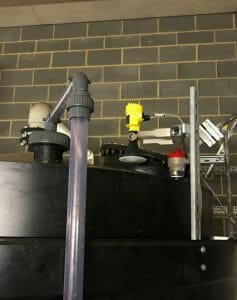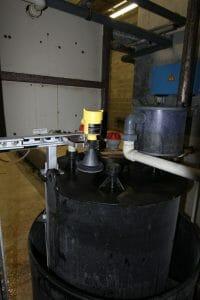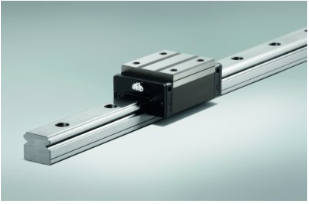Cory Riverside Energy is a waste to energy plant to the East of London. With a population approaching nine million people, London has an incredible appetite for energy. Keeping the lights on in the face of increasing demand is one of the major challenges facing the city today. It produces around 22 million tonnes of waste every year. Or, to put it another way, enough to fill the largest skyscraper at Canary Wharf every eight days. At this site they utilise this waste to help provide London with a safe, secure, affordable and sustainable energy supply, which also makes great environmental sense. The site at Belvedere uses these materials, that would otherwise have gone to landfill, as a feedstock to generate electricity. As one of the largest operations of its kind in the UK, this facility generates c.525,000 MWh of electricity each year from processing around 750,000 tonnes of waste. What’s more, they use the River Thames as a ‘green highway’ to move the waste from the centre of the city to the facility on their fleet of tugs and barges, removing around 100,000 truck movements a year off the UK capital’s congested roads.
Chemical storage on site
The energy from waste combustion process presents many challenges, from bulk handling of the incoming waste streams to the careful monitoring and control of the outputs to the environment. At various stages chemicals are used on their purified water systems. These chemicals are stored in bulk storage tanks at strategic points across the plant, in one such area there are 4 polypropylene plastic chemical tanks containing Sodium Hydroxide (Caustic Soda) 32% and Hydrochloric acid (32%) – each product utilising a ground floor bulk storage vessel and a smaller ‘day’ tank’ on an upper floor, used for the process-critical dosing and neutralisation. All tanks had been originally supplied fitted with low cost ‘back pressure’ level systems that failed due to corrosion and build up. With fumes and vapours escaping through the housings, they were unreliable, inaccurate and very unsafe.
Risks with chemicals
To get the right sensor specification means it needs to be made of the right materials, sometimes needing expensive alloys and elastomer seals in the construction. During fitting or removal, both sensor and process will also require containment, isolation and decontamination, as well as comprehensive personal protection equipment ( i.e. COSSH regulations). This often results in mandatory closing off an area of the plant while any equipment installation or removal is taking place on the vessel. These necessary health and safety procedures incur extra safety risks and cost.
When storing chemicals, especially those that are highly acid or alkali, they are generally highly toxic, corrosive substances that can leave residues and readily give off vapours and fumes. Any contact with, or release into the atmosphere can quickly create a very hazardous environment for personnel. At Cory, these chemical products require careful monitoring and accurate level measurement to remove any risk of overfill, and ensure the process has ample supply.
“We wanted a new level system that would avoid any repeat of the issues with the original sensors, ideally eliminating process contact and any risks experienced with the previous technology.” Said the Cory instrument engineer. VEGA proposed to use contactless radar sensors mounted above and outside the vessels looking through the vessel top to measure the liquid level inside.
Contactless level measurement benefits
When it comes to liquid level measurement of chemicals a sensor generally requires a process connection into the vessel to get its ‘sensing part’ to connect into the process – even when using a top mounted ‘non contact’ device – it could be a rod, cable or diaphragm. So, to be able to measure any process variable completely without contact provides many benefits; from longevity of operation, protection from chemicals and the process, along with the increased safety through reduction or complete elimination of exposure to harmful substances. Radar has quite a unique ability to measure the level of a liquid down right through an opaque plastic vessel top or window on a nozzle, completely from the outside.
Plastic vessels
With new materials and manufacturing techniques, more and more companies are utilising plastic vessels and tanks for chemical and bulk liquid storage. These are quicker to make, are generally more cost effective and have good chemical resistance, as well as being lighter to manoeuvre during installation. They can also offer a longer lifespan and lower maintenance than equivalent steel painted, lined or coated vessels, for example. Many even come with ‘integrated bunds’ for overflow or overspill protection. We also see plastic IBC’s as one of the most common vessels for bulk transport of intermediate quantities of liquid. Radar technology can be used to measure liquid level through the top of all these vessel types.
How does radar see through plastic vessels?
Radar uses microwave technology. Just as you see every day in a microwave oven using plastic glass and other non metallic, non-conductive containers that allow the microwaves to pass through and only interact and heat the conductive, water-based foods inside. (that’s why you cannot heat dry powders in a microwave oven). A level radar has the same capability, it can transmit signals through plastic and other non conductive materials (like glass and ceramic) and reflect back off a liquid level inside. And, with a good dynamic range (sensitivity) it can also deal with any condensate or sublimation on the inside of the vessel roof.

VEGAPULS radar mounted off ‘unistrut’ bracket above the bulk storage vessel looking through the top to measure Hydrochloric acid level inside
Why use 80 GHz technology?
Using 80 GHz radar offers several benefits; firstly the higher focusing means it achieves good penetration through the plastic vessel roof, it also offers more mounting position options (i.e. closer proximity to vessel wall or nozzles) and less likely to pick up any unwanted false signals. They also have a wide measuring range capability from very small to very tall vessels, up to 30m high. Lastly, high dynamic sensitivity to handle condensation and build up inside the roof caused by fumes or sublimation from the products inside. It can even measure low reflectivity, oil-based hydrocarbons in some applications of this type.
Installation best practice
Installing the radars above the tank on a suitable bracket perpendicular to the liquid surface is essential, and allow a small gap between it and the vessel top (see fig 3 and 4). A sloping roof-top is ideal for a microwave sensor to look through, as any unwanted signal reflected back by the roof is deflected away from the radar. If this is not possible and the roof is flat like an IBC or the smaller day tanks show in fig. its not a major issue, the sensitivity of the radar will easily overcome this. If a tank is outside, a cover to stop snow forming directly beneath the sensor and select a position that will eliminate the chance of any water puddles from forming directly beneath as a radar cannot see through water! Rainfall down a sloping roof tank situated outside will not affect the sensor performance. Never mount the radar looking directly down the wall, make sure it is a little way in from the edge (VEGAPULS radar IOM shows this in detail). As the Cory engineer testified, “VEGA engineers are always happy to help you and advise on installation.”

Radars are mounted above each of the smaller acid and caustic day tanks measuring the liquid level from outside the vessel, for ultimate safety
Safer measurement and control
Cory Riverside Energy has the first radar is successfully working through the roof of the bulk chemical tank, mounted on simple ‘unistrut’ frame and a VEGA–supplied radar bracket that attaches to them (see fig 3). The units only needed a basic set up for the minimum and maximum level distances the VEGAPULS sensor software and sensitivity took care of the rest. “They are simple to use and the Bluetooth communication for set up via smart device App or with a PC and PACTware makes it so much easier” added the engineer. “The others have been tested and awaiting to go online now.”
Operating using radar technology through plastic tanks (and even glass windows on reactors etc.) offers great advantages in safety, reliability, chemical compatibility (not forgetting savings on instrument specifications) and time saving installation. “VEGAPULS radar offers us great flexibility for safe operation of chemical storage vessels and process control on site”, the engineer concluded.








